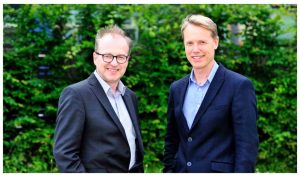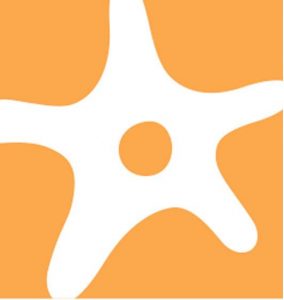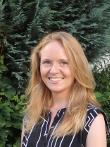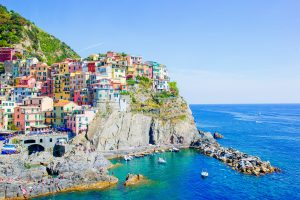
Prof. Waldemar Kolanus (Vice-Speaker) and Prof. Gunther Hartmann (Speaker) of the ImmunoSensation Cluster of Excellence. (picture by J. Saba, UKB)
Today, it’s been five years since the ImmunoSensation Cluster of Excellence as we know it was launched. Now, after many busy and successful years, its period of funding will end, and it is time to think about the future of immunology research in Bonn. Fortunately, in September 2017, the follow-up concept ImmunoSensation² was invited to submit a full application for the next funding period of the Excellence Strategy. Since we were excited about the success of ImmunoSensation and curious to find out more about the future plans to support immunological research in Bonn, we decided to talk to the ImmunoSensation speaker, Prof. Gunther Hartmann and vice speaker, Prof. Waldemar Kolanus, about the origins of ImmunoSensation, its goals, achievements and challenges, as well as their hopes and vision for the future concept ImmunoSensation2.
First steps towards ImmunoSensation
 “Many years ago it became quite clear that we wanted to establish a cluster of excellence to foster immunology in Bonn,” Prof. Hartmann recollected. Here, the collaboration of the Medical Faculty and the Faculty for Mathematics and Natural Sciences was crucial, since both had strategically invested towards strengthening the immunological research focus in Bonn for many years. Prof. Kolanus also noted that “the existing SFB704 on local immune regulation was a strong foundation for an excellence cluster.” For close collaborations and innovative concepts, many people from different institutes and research areas had to be brought into close contact, an exciting if very challenging prospect.
“Many years ago it became quite clear that we wanted to establish a cluster of excellence to foster immunology in Bonn,” Prof. Hartmann recollected. Here, the collaboration of the Medical Faculty and the Faculty for Mathematics and Natural Sciences was crucial, since both had strategically invested towards strengthening the immunological research focus in Bonn for many years. Prof. Kolanus also noted that “the existing SFB704 on local immune regulation was a strong foundation for an excellence cluster.” For close collaborations and innovative concepts, many people from different institutes and research areas had to be brought into close contact, an exciting if very challenging prospect.
One coast – one solution
Together, it was concluded that a shared retreat among potential applicants would help to develop a concept because “an excellence cluster demands a lot more than an SFB – more vision, perspectives and long-term aspects,” as Prof. Hartmann explained. To promote scientific exchange and to fuel their creativity, they chose Cinque Terre in Italy, which is famous for its beautiful coastline, picturesque surrounding hillsides, and is one of the UNESCO World Heritage Sites. Who couldn’t be inspired walking up and down that idyllic coastline? Importantly, inspiration for an innovative and conclusive concept was needed. “Immunology is a field,” and “if you go into a certain part of immunology, it is too short-lived and too narrow for an excellence cluster,” emphasized Prof. Hartmann. “Following the bottom-up strategy, innate immunity, infection and inflammation had to be brought together without excluding adaptive immunity, neurology and other fields, which are essential to combat the future challenges in immunology” added Prof. Kolanus. At this time, many aspects remained unclear, except the conclusion that “the strength we have is that this group is unique, has one vision, and aims to bring immunology to the next level,” Prof. Hartmann recollected.
There is a key to every lock
Naturally, for a successful cluster of excellence application certain formal requirements have to be met, including a good publication record, third party funding, collaborative research grants, a number of translational projects, start-up companies and patents. “Luckily, we have all of this in Bonn,” noted Prof. Hartmann. Thus, the real challenge was to “unite a group of people from different angles of expertise and then come up with something truly new.”
To achieve this, the shared visions and common denominators had to be determined. Soon, sterile inflammation became a key word in the cluster concept. Nevertheless, two challenges had to be addressed: First, “immune responses are not limited to immune cells but other cells participate in immune reactions as well, for example by expressing cytokine receptors (e.g. for IL-1),” Prof. Kolanus remarked. Thus, the concept of ImmunoSensation had to include the participation of non-immune cells in immune reactions and thus go beyond the classical immune system of T cells, B cells, macrophages, dendritic cells etc. Second, the whole organism has to constantly distinguish foreign from self and differentiate in each case between damage and non-damage, threatening and benign. Prof. Hartmann added that “for an encompassing concept, somatic non-immune cells such as neurons, liver cells, epithelial cells etc are included for an advanced understanding of the mechanisms involved in cell communication within the body. How does a complex system like this work with so many mobile circulating cells? How do these many different cells come up with one solution? Clearly, they have to integrate the signals they receive to come up with one decision.”
Consequently, it all came down to the smallest common unit, the immune receptors. “Immune receptors, as the smallest sensing unit, bridge innate and adaptive immunity,” Prof. Hartmann explained. Since these receptors are the core of the sensory system, they from now on were referred to as “sensing receptors”.
Aiming high – ImmunoSensation’s contribution to science and society

(image from colourbox.com)
Prof. Hartmann and Prof. Kolanus agreed that great progress has been made in all the five areas of the cluster including (A) Ligand Sensing and Signalling, (B) Local Tissue Context, (C) Metabolic Sensing and Nervous-Immune System interactions, (D) Signal Integration, and (E) Sterile Inflammation in vivo. Fortunately, within the past few years, so many exciting new findings have been made in all the research areas of the cluster that we can’t detail all of them in this brief blog article. In summary, core discoveries were made in inflammasome research, in Alzheimer and cardiovascular disease, in particular, concerning the contribution of sterile inflammation to atherosclerosis, and within the area of innate immune recognition, where the identification of minimal Y-form DNA recognized by cGAS and the identification of the exact structure of a signaling molecule in the cGAS/STING pathway have already begun to have therapeutic applications. Furthermore, advances in functional genomics at the single cell level are an example of the remarkable technological successes of the past few years. Prof. Hartmann and Prof. Kolanus were particularly proud of the achievements in neurodegenerative disease and neuroinflammation research as well as the overall structures that were created within the past years, including “a strategy to recruit young scientists, foster gender equality, and to establish a competitive curriculum for graduate education,” as Prof. Kolanus emphasized.
A new venture and expanding vision
As we found out, the general concept of ImmunoSensation2 is derived from the current concept of ImmunoSensation but introduces several substantial changes. “If ImmunoSensation2 makes it into the top 50 applications granted, it will provide essential funding for immunological research in Bonn for up to 14 years (two 7 year periods) from 2019 onwards,” Prof. Kolanus explained. “While ImmunoSensation was focused on characterizing immune sensing receptors, the overall goal of ImmunoSensation2 is to understand the principles of immune responses in a way that it will be possible to reliably predict immunological outcomes and elicit innate, acquired and memory responses to reliably guide prophylactic and therapeutic interventions,” Prof. Hartmann concluded.
We thank Prof. Hartmann and Prof. Kolanus very much for talking to us about the past, present, and future of immunology research in Bonn. With these ambitious goals, their attitude that “you should never look at science as a job – it’s a privilege,” as Prof. Hartmann says, and the strength with which this group of applicants and associated scientists sticks together, we are confident that ImmunoSensation2 will lead immunological research in Bonn into a successful future.

Larissa Mühlenbeck

